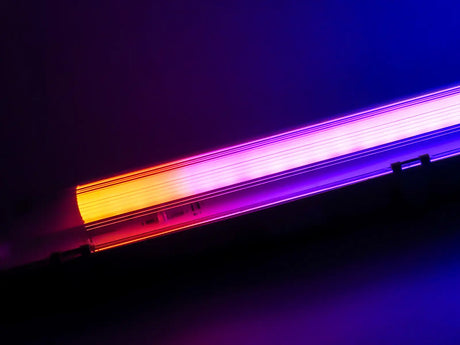What are lumens?
The description and specifications of LED bulbs always include the amount of lumens. But what does that actually mean? Lumen indicates the luminous intensity, or light output, of a bulb. It indicates how bright a bulb is by measuring how much visible light it emits from all directions. Thus, the number of Lumen indicates how much light a lamp produces per unit of time. Usually, the intensity of light (as an electromagnetic wave) is given in W/m².
The luminous flux is the total amount of light in a beam. The luminous flux depends on the power of the source and on the color of the light. On average, an LED bulb produces a luminous flux of 40 to 100 lumens per watt. However, this can be as high as 200 lumens per watt.
What are high lumen LED bulbs?
The more lumens per watt the more light output the lamp produces. From 120 lm/w we talk about high lumen. This means that per 1 watt 120 lumens of light output is produced. So this is very strong/full light. Led lamps with high lumen are sometimes more expensive than a comparable lamp with less lumen but the more light output per watt the more the lamp saves compared to traditional lighting. This is because you sometimes generate up to 85% more light output for the same power. High lumen lamps are often used for business and professional purposes. Because the high light output provides better visibility and higher productivity. In domestic settings, this is not always necessary unless the light is used for a hobby or room where it is desired. For example, in a shed, garage or hobby room.
What is the difference between the amount of watts and lumens of a lamp?
The amount of watts indicates the energy consumption of a lamp and not its light output (its brightness or brilliance). So when buying LED lights, it is important to look at the amount of Lumens rather than the Wattage.
Below we have compared the Lumens to the wattage of an LED bulb, a Halogen bulb, an energy-saving bulb and an incandescent bulb.
|
Lamp type
|
50-200 Lumen |
200-300 Lumen | 300-500 Lumen | 500-700 Lumen | 700-1000 Lumen | 1000-1250 Lumen | 1250-2000 Lumen |
|
LED |
1-2 Watt | 2-3 Watt | 3-5 Watt | 5-7 Watt | 7-11 Watt | 11-13 Watt | 13-20 Watt |
|
Halogen |
18 Watt | 18-28 Watt | 35 Watt | 60 Watt | 65 Watt | 100 Watt | 120 Watt |
|
Energy-saving lamp |
5 Watt | 7 Watt | 10 Watt | 13 Watt | 13-17 Watt | 17-22 Watt | 22-33 Watt |
|
Incandescent lamp |
25 Watt | 35 Watt | 40 Watt | 50 Watt | 60-80 Watt | 80-100 Watt | 100-150 Watt |
How many lumens you need for each room in your home is difficult to say. It depends on the size of the room, type of lamps and of course your own taste. To give you an idea, we have a simple diagram with an average Lumen usage per room. Keep in mind that this is an average use per room. Make your choice based on your personal situation (furnishing, taste). The more lumens, the more light.
|
Space |
Lumen per m² |
|
Kitchen |
700-800 |
|
Livingroom |
400-500 |
|
Bedroom |
300-400 |
|
Bathroom |
700-800 |
|
Hallway |
300 |
What is Lux?
The lux (symbol lx) is a unit of illuminance: 1 lux is the illuminance produced by a light source with a luminous intensity of 1 candela on a surface perpendicular to the light rays at a distance of 1 meter from the source. The lux therefore corresponds to the illuminance obtained when each square meter of the surface under consideration receives a luminous flux of one lumen. Consequently, the number of lux is found as the quotient of the total luminous flux received, expressed in lumens, and the size of the illuminated area expressed in square meters. 1 lux = 1 lumen/m².
Examples of Lux
- Sunlight: 100,000 - 130,000 lux (100 - 130 klx)
- Daylight, indirect sunlight: 10 000 - 20 000 lux (10 - 20 klx)
- Cloudy day: 1000 lux (1 klx)
- Sunrise / sunset on a clear day: 400 lux
- Office: 300 - 500 lux
- Train station (open) platform: 5 - 20 lux
- Very dark day: 100 lux
- Office building hall, toilet lighting: 80 lux
- Living room: 50 lux
- Public areas with dark surroundings: 20 - 50 lux
- Twilight: 10 lux
- Dark twilight: 1 lux
- Full moon: 0.1 lux
- Quarter moon: 0.01 lux (10 mlx)
- New moon without clouds: 0.001 lux (1 mlx)
- Cloudy night without moon: 0.0001 lux (0.1 mlx)

